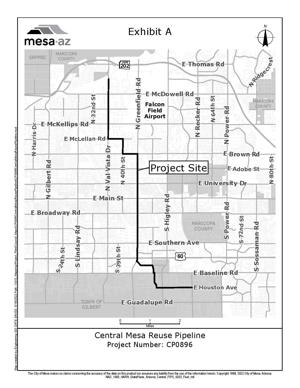CITY OF MESA WATER-PIPE DREAMS: Discharge of Wastewater Effluent
Intro: Water is the most precious commodity here in the desert - it's a limited finite natural resource required for endless unsustainable Suburban Sprawl and rampant real estate speculation gone crazy here in the Southwest. It is The Giver of Life and closely held to benefit everyone in the centuries-old beliefs and cultures of The Gila River Indians who were here before "The Pioneers" were sent from Utah to colonize Arizona. . .
Here's some of that history:
"In the latter nineteenth century, few American Indians had rights that powerful economic interests were bound to respect. These speculative interests in central Arizona Territory's Salt River Valley understood this and influenced federal bureaucrats and policymakers to adopt a scheme giving them access to the natural resources of the Gila River Indian Reservation. Led by A. J. Chandler and his Detroit investors, speculators took advantage of a series of poorly written, loosely interpreted, and badly managed federal laws at the turn of the twentieth century and initiated a battle over control of scarce American Indian land and water resources. At stake was the economic and cultural survival of the Pima residing on the Gila River Indian Reservation. . ." -----------------
David DeJong (2014) "Down to the Gila": A. J. Chandler's Desert Land Scheme and the Gila River Indian Reservation, 1891-1911. American Indian Culture and Research Journal: 2014, Vol. 38, No. 3, pp. 1-24.
"Down to the Gila": A. J. Chandler's Desert Land Scheme and the Gila River Indian Reservation, 1891-1911
>>>
Mesa moving on massive pipeline for more water

When finished, the planned 3-foot-wide underground pipeline would move millions of gallons of reclaimed wastewater a day 10 miles south from the Northwest Wastewater treatment plant at Thomas Road and Val Vista Drive for ultimate delivery to the Gila River Indian Community’s agricultural fields.
With an estimated $90 million price tag, the project is a major undertaking, both financially and in terms of public inconvenience during construction, which could last up to two years.
 But the city believes the costs and impacts will be worth it, potentially expanding Mesa’s access to Colorado River water at a relatively cheap price.
But the city believes the costs and impacts will be worth it, potentially expanding Mesa’s access to Colorado River water at a relatively cheap price.
That’s vital for continued growth, leaders say, particularly for southeast Mesa, where industrial growth is rapid and current and prospective users are seeking access to large volumes of water.

Following a study of routes, officials selected a path for the pipeline completely within city rights-of-way beneath public streets, meaning crews will have to dig up portions of roadways to install the pipeline.
The pipeline route heads south down Val Vista Drive until McLellan Road, where it turns east before arriving at Greenfield Road via 40th Street and Brown Road. The pipeline then follows Greenfield Road south, crosses US 60, then turns southwest before connecting with an existing pipeline at Recker and Houston Roads. . .
===============================================================
Water
> Meet the conditions of the agreement
> Gain additional water supplies
 Provides an economical and stable option for long term water supply while still providing a great return on investment
Provides an economical and stable option for long term water supply while still providing a great return on investmentThe Gila River Community prefers to maintain delivery of water through the existing delivery system
PROJECT OVERVIEW
Goal: Deliver Reclaimed Water from City’s Northwest Wastewater Reclamation Plant to the Gila River Community to Maximize Water Exchange
> Utilize Existing Infrastructure
> Connect City’s Reclaimed Waterline from North Central Mesa to the City’s Southeast Wastewater Reclamation Plant
Considerations Used to Evaluate Alternatives
". . .City Manager Chris Brady told the council in 2021 that the pipeline project would likely be fully or partially funded by future bond packages.
Many cities in the Southwest are looking to their treated effluent water to stretch their water portfolios, using reclaimed water to irrigate places like golf courses and city parks – locations that might otherwise use drinking water.
Mesa’s Northwest water treatment plant can churn out up to 18 million gallons of effluent a day, but the city has a problem: it currently has limited options for delivering that water.
It lacks infrastructure in the form of pipes to send it around the city for beneficial uses.
Most of the Northwest Water Reclamation Plant effluent is currently sent underground via the Salt River Project’s Granite Reef Underground Storage Project, a basin at the Salt River bed where surface water is absorbed into the aquifer.
When a storm in 2020 knocked GRUSP offline, Mesa sent effluent down the Salt River channel for about a year.
While storage has benefits – Mesa Water Resources Director Chris Hassert told city council in May the city has banked almost six years’ worth of water underground and managers think they can make the city’s effluent work harder by building the Central Mesa pipeline.
 Mesa has a 99-year deal with the Gila River Indian Community to trade effluent water for Colorado River water credits from the Central Arizona Project.
Mesa has a 99-year deal with the Gila River Indian Community to trade effluent water for Colorado River water credits from the Central Arizona Project.
With the new pipeline, Mesa would be able to increase the effluent it trades to GRIC from 6,800 acre-feet per year to as much as 20,000 acre-feet, Hassert said. . ."
==================================================
RELATED
_________________________________________________________________________
Here's City Staff Planner Tom Ellsworth making a presentation on Water Asset Management in front of a public Mesa City Council Study Session earlier this month on October 7, 2019.
There's $800,000,000 on-the-table and on the agenda for Capital Improvement Project for discussion.








No comments:
Post a Comment